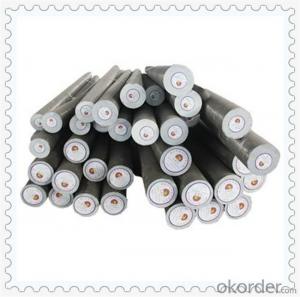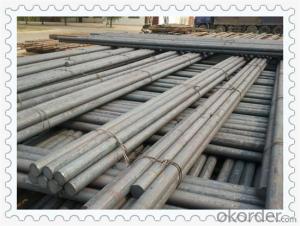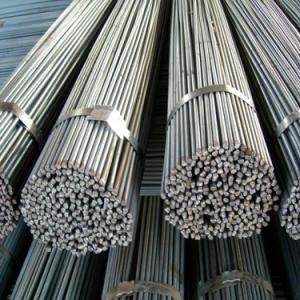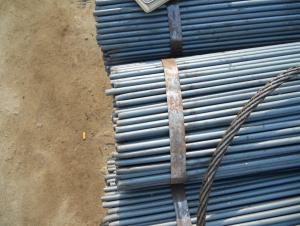Alloy Steel AISI 4340 Materials 1.6582
- Loading Port:
- China main port
- Payment Terms:
- TT OR LC
- Min Order Qty:
- 50 m.t.
- Supply Capability:
- 10000 m.t./month
OKorder Service Pledge
OKorder Financial Service
You Might Also Like
Alloy Steel AISI 4340 Materials 1.6582
Products Details
Similar or Equivalent Grades
GB | ASTM | JIS | ISO |
40CrNiMoA | 4340 | SNCM439 | 36CrNiMo4 |
Chemical composition
Standard |
Grade |
C |
Cr |
Ni |
Mo |
Si |
Mn | P | S | Cu |
≤ | ||||||||||
GB | 5CrNiMo | 0.37-0.44 | 0.60-0.90 | 1.25-1.35 | 0.15-0.25 | 0.17-0.37 | 0.50-0.80 | 0.025 | 0.025 | 0.30 |
JIS | SNCM439 | 0.36-0.43 | 0.60-1.00 | 1.60-2.00 | 0.15-0.30 | 0.15-0.35 | 0.60-0.90 | 0.030 | 0.020 | 0.30 |
ASTM | 4340 | 0.38-0.43 | 0.70-0.90 | 1.65-2.00 | 0.20-0.30 | 0.15-0.35 | 0.65-0.85 | 0.025 | 0.025 | — |
ISO | 38CrNiMo4 | 0.32-0.40 | 0.90-1.20 | 0.90-1.20 | 0.15-0.30 | 0.10-0.40 | 0.50-0.80 | 0.035 | 0.035 | — |
Mechanical Property
Tensile strength | Yield strength | Elongation rate | Contractibility rate | Impact Energy | Hardness(HBS100/3000) |
≥980MPa | ≥835MPa | ≥12% | ≥55% | ≥78J | ≤269 |
Characteristics
1) High hardability.
2) High strength and toughness.
3) Poor cold deformation plasticity and weldability.
4) Poor corrosion resistance.
Application
Bent axle of engine, cross beam, undercarriage, pressure vessel, torsion shaft, transmission shaft, frictionclutch shaft, etc.
Products Show

Product Overviews
| Product Name | Typical Grades | Diameter(mm) | Standard adopted |
| Carbon Steel | 20 (1020/S20C/C22) | Ø16-Ø300 |
GB/SAE/JIS/DIN
|
| 40 (1040/S40C/C40) | |||
| 45 (1045/S45C/C45) | |||
| Bearing Steel | GCr9 (51100/SUJ1) | Ø12-Ø250 | |
| GCr15 (52100/SUJ2/100Gr6) | |||
| GCr9SiMn (A485-Gr.1/SUJ3) | |||
Cr-Mo Steel | 20Cr (5120/SCr420H/20Cr4) | Ø12-Ø250 | |
| 40Cr (5140/SCr440/41Cr4) | |||
| 42CrMo(4140/SCM440/42CrMo4) | |||
| Gear Steel | 20CrNiMo | Ø16-Ø600 | |
| 20CrMn(5115/SMnC420/20MnCr5) | |||
| 20CrNiMo(8620/SNCM220/20CrMiMo2) |
Application
| Carbon Steel | Mold bottom, Plastic mold, Construction machinery parts Automobile parts, Security grills, Screens, Construction |
| Bearing Steel | Aerospace, Navigation, Nuclear energy, Chemical industry Electronic information, Petrochemical, Instrument and meter Transportation |
| Cr-Mo Steel | Mechanism & Fasteners gear, Stressed components for vehicles Engines and machines, Parts of larger cross-section |
| Gear Steel | All kinds of gears, Statically and dynamically stressed component for vehicles Engines and machine, Larger cross-section parts, Crankshafts |
Work Shop

Company Information
CNBM International Corporation is the most important trading platform of CNBM group.
Whith its advantages, CNBM International are mainly concentrate on Cement, Glass, Iron and Steel, Ceramics industries and devotes herself for supplying high qulity series of refractories as well as technical consultancies and logistics solutions.


FAQ
1, Your advantages?
professional products inquiry, products knowledge train (for agents), smooth goods delivery, excellent customer solution proposale
2, Test & Certificate?
SGS test is available, customer inspection before shipping is welcome, third party inspection is no problem
3, Factory or Trading Company?
CNBM is a trading company but we have so many protocol factories and CNBM works as a trading department of these factories. Also CNBM is the holding company of many factories.
4, Payment Terms?
30% TT as deposit and 70% before delivery.
Irrevocable L/C at sight.
5, Trading Terms?
EXW, FOB, CIF, FFR, CNF
6, After-sale Service?
CNBM provides the services and support you need for every step of our cooperation. We're the business partner you can trust.
For any problem, please kindly contact us at any your convenient time.
We'll reply you in our first priority within 24 hours.
Packaging & Delivery
1, Packaging: seaworthy package or as required
2, Delivery: 35-45 days or based on quantity

- Q:Can steel round bars be used in the production of HVAC equipment?
- Yes, steel round bars can be used in the production of HVAC equipment. Steel round bars are often used to create the structural framework and components of HVAC systems. They provide strength, durability, and stability necessary for various parts such as supports, brackets, and frames. Additionally, steel round bars can be easily fabricated, welded, and shaped to meet the specific requirements of HVAC equipment.
- Q:What is the difference between hot rolled and cold rolled steel round bars?
- The main difference between hot rolled and cold rolled steel round bars lies in the process of production. Hot rolled steel round bars are formed by heating the steel above its recrystallization temperature and then rolling it into the desired shape. This process makes the steel more malleable and ductile, resulting in a rougher surface finish. On the other hand, cold rolled steel round bars are formed by rolling the steel at room temperature. This process produces a smoother surface finish and tighter dimensional tolerances, but it also makes the steel less malleable. Overall, the choice between hot rolled and cold rolled steel round bars depends on the specific application and desired characteristics of the end product.
- Q:How do you straighten steel round bars?
- To straighten steel round bars, you can use a variety of methods depending on the level of precision required and the size of the bars. Here are a few common techniques: 1. Manual Straightening: This method is suitable for smaller diameter round bars. Place the bar on a flat surface and apply pressure to the bent section using a hydraulic or manual press. Gradually increase the force until the bar is straightened. This technique is relatively simple but may not yield perfect results. 2. Heat Straightening: Heat straightening is effective for larger diameter round bars or bars with severe bends. Heat the bent section using an oxy-acetylene torch until it becomes red hot. Once heated, apply pressure in the opposite direction of the bend using hydraulic or manual tools. The heat softens the steel, allowing it to be manipulated easier. Be cautious not to overheat the steel, as it may weaken its structural integrity. 3. Roller Straightening: This method is commonly used in industrial settings and is suitable for larger diameter round bars. The bar is passed through a series of rollers that apply pressure to the bent section, gradually straightening it. This technique provides precise and uniform results but requires specialized equipment. 4. Hydraulic Press Straightening: For precision straightening, a hydraulic press can be used. Place the bar between two parallel plates and apply pressure using the hydraulic press. Gradually increase the force until the bar is straightened. This method is suitable for bars with minor bends and allows for precise control over the straightening process. It is essential to note that while these methods can straighten steel round bars, the effectiveness may vary depending on the severity of the bend, the quality of the steel, and the equipment used. It is advisable to consult with a professional or follow industry-specific guidelines to ensure safe and accurate straightening of steel round bars.
- Q:What are the safety precautions to be taken while handling steel round bars?
- To prevent accidents and injuries when working with steel round bars, it is crucial to adhere to specific safety measures. Here are several precautions that should be taken: 1. Personal Protective Equipment (PPE) is essential. Wear suitable gear, such as safety goggles, gloves, and steel-toe boots, to safeguard against potential hazards like flying debris, sharp edges, and crushing injuries. 2. Employ proper lifting techniques. Bend your knees and use your leg muscles instead of your back to avoid strain or back injuries. Do not attempt to lift heavy steel round bars alone; seek assistance or utilize lifting equipment like cranes or forklifts. 3. Ensure secure storage. Store steel round bars in a stable and secure designated area or rack. Organize and stack them correctly to prevent falling or rolling onto individuals. 4. Utilize appropriate handling tools. Use tools like tongs or lifting hooks to handle steel round bars. Refrain from using your hands or fingers directly to avoid cuts or pinching injuries. 5. Conduct inspections. Before handling steel round bars, inspect them for defects, sharp edges, or protrusions that may pose safety risks. Report any issues to the appropriate personnel and do not use the bars until they are repaired or replaced. 6. Maintain clear communication with co-workers. Especially in situations involving multiple individuals, employ hand signals or verbal cues to coordinate movements and avoid accidental collisions. 7. Ensure proper storage and transportation. When storing or transporting steel round bars, secure them adequately and provide sufficient support to prevent shifting, sliding, or falling during movement. 8. Provide comprehensive training. Train all personnel involved in handling steel round bars, covering proper lifting techniques, the use of PPE, and awareness of potential hazards and safety procedures. By adhering to these safety precautions, the risk of accidents and injuries while working with steel round bars can be minimized. Always prioritize safety to create a secure working environment for yourself and those around you.
- Q:What are the different types of steel round bar heat treatments?
- There are several different types of heat treatments for steel round bars, each designed to enhance specific properties of the material. Some of the most common heat treatments include annealing, normalizing, quenching and tempering, and case hardening. 1. Annealing: This heat treatment involves heating the steel round bar to a high temperature and then slowly cooling it to room temperature. Annealing helps to relieve internal stresses, improve machinability, and increase ductility and toughness. 2. Normalizing: Similar to annealing, normalizing also involves heating the steel round bar to a specific temperature. However, instead of slow cooling, the bar is allowed to cool in air. Normalizing helps to refine the grain structure, enhance mechanical properties, and improve machinability. 3. Quenching and Tempering: Quenching is a process in which the steel round bar is heated to a high temperature and then rapidly cooled by immersing it in a quenching medium, such as oil or water. This rapid cooling helps to achieve high hardness and strength in the material. After quenching, the steel is often tempered by reheating it to a lower temperature, which improves toughness and reduces brittleness. 4. Case Hardening: This heat treatment is used to increase the surface hardness of the steel round bar while maintaining a tough core. Case hardening involves heating the bar in the presence of carbon-rich substances, such as gas or liquid carburizing agents. This results in a hardened outer layer, known as the case, while the core remains relatively softer and more ductile. These are just a few examples of the various heat treatments that can be applied to steel round bars. The specific heat treatment used depends on the desired properties and applications of the steel, and it is important to consult with metallurgical experts to ensure the most appropriate treatment is chosen for each specific steel round bar.
- Q:Can steel round bars be used in the manufacturing of appliances?
- Yes, steel round bars can be used in the manufacturing of appliances. Steel is a durable and versatile material that can be shaped into different forms, including round bars, which can be used for various purposes in appliance manufacturing such as structural support, handles, or components.
- Q:Are steel round bars available in metric sizes?
- Yes, steel round bars are available in metric sizes.
- Q:Are steel round bars suitable for machining?
- Indeed, machining is a suitable application for steel round bars. Due to their remarkable machinability, steel round bars are frequently employed in diverse machining procedures. These bars can be effortlessly molded, sliced, bored, and rotated using various machining methods like milling, turning, drilling, and grinding. By offering commendable dimensional stability, exceptional strength, and outstanding wear resistance, steel round bars prove to be an ideal choice for machining operations. Moreover, the availability of different grades and alloys further expands the scope of machining applications in industries spanning automotive, aerospace, construction, and manufacturing.
- Q:Can steel round bars be used in the agricultural industry?
- Yes, steel round bars can be used in the agricultural industry. They have a wide range of applications in this sector, such as constructing fences, gates, and livestock enclosures. Steel round bars are also commonly used as support and reinforcement in structures like barns, sheds, and agricultural machinery. Their high strength and durability make them ideal for withstanding the harsh conditions and heavy loads typically found in agricultural settings. Additionally, steel round bars can be further processed and fabricated into various agricultural tools and equipment, including hitches, plows, and cultivators. Overall, steel round bars are a versatile and reliable material that can effectively meet the demands of the agricultural industry.
- Q:How do I choose the right grade of steel round bar for my application?
- Choosing the right grade of steel round bar for your application depends on several factors. Firstly, consider the specific requirements of your application such as the desired strength, hardness, corrosion resistance, and machinability. Additionally, assess the environmental conditions the steel will be exposed to, such as temperature, humidity, and chemical exposure. Consulting with a materials engineer or steel supplier can provide valuable guidance, as they can recommend grades that align with your application's needs and budget. Ultimately, selecting the right grade of steel round bar requires careful consideration of these factors to ensure optimal performance and longevity.
1. Manufacturer Overview |
|
|---|---|
| Location | |
| Year Established | |
| Annual Output Value | |
| Main Markets | |
| Company Certifications | |
2. Manufacturer Certificates |
|
|---|---|
| a) Certification Name | |
| Range | |
| Reference | |
| Validity Period | |
3. Manufacturer Capability |
|
|---|---|
| a)Trade Capacity | |
| Nearest Port | |
| Export Percentage | |
| No.of Employees in Trade Department | |
| Language Spoken: | |
| b)Factory Information | |
| Factory Size: | |
| No. of Production Lines | |
| Contract Manufacturing | |
| Product Price Range | |
Send your message to us
Alloy Steel AISI 4340 Materials 1.6582
- Loading Port:
- China main port
- Payment Terms:
- TT OR LC
- Min Order Qty:
- 50 m.t.
- Supply Capability:
- 10000 m.t./month
OKorder Service Pledge
OKorder Financial Service
Similar products
New products
Hot products
Related keywords

































